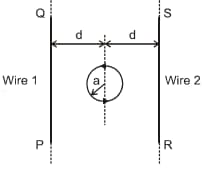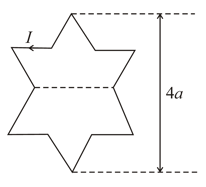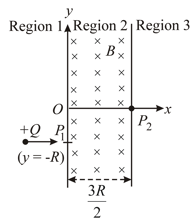A steady current flows along an infinitely long hollow cylindrical conductor of radius . This cylinder is placed coaxially inside an infinite solenoid of radius . The solenoid has turns per unit length and carries a steady current . Consider a point at a distance r from the common axis. The correct statement(s) is (are) :

Important Questions on Magnetic Effect of Current
The figure shows a circular loop of radius a with two long parallel wires (numbered and ) all in the plane of the paper. The distance of each wire from the centre of the loop is . The loop and the wires are carrying the same current . The current in the loop is in the counterclockwise direction if seen from above.

Consider , and the loop is rotated about its diameter parallel to the wires by from the position shown in the figure. If the currents in the wires are in the opposite directions, the torque on the loop at its new position will be (assume that the net field due to the wires is constant over the loop)
A conductor (shown in the figure) carrying constant current is kept in the plane in a uniform magnetic field . If is the magnitude of the total magnetic force acting on the conductor, then the correct statement(s) is (are)

A charged particle (electron or proton) is introduced at the origin with a given initial velocity. . A uniform electric field and a uniform magnetic field exist everywhere. The velocity , electric field and magnetic field are given in column and , respectively. The quantities are positive in magnitude.
| Column-1 | Column-2 | Column-3 | |||
| (I) | Electron with | (i) | (P) | ||
| (II) | Electron with | (ii) | (Q) | ||
| (III) | Electron with | (iii) | (R) | ||
| (IV) | Electron with | (iv) | (S) |
In which case will the particle move in a straight line with constant velocity ?
A charged particle (electron or proton) is introduced at the origin with a given initial velocity. . A uniform electric field and a uniform magnetic field exist everywhere. The velocity , electric field and magnetic field are given in column and , respectively. The quantities are positive in magnitude.
| Column-1 | Column-2 | Column-3 | |||
| (I) | Electron with | (i) | (P) | ||
| (II) | Electron with | (ii) | (Q) | ||
| (III) | Electron with | (iii) | (R) | ||
| (IV) | Electron with | (iv) | (S) |
In which case would the particle move in a straight line along the negative direction of axis, (i.e, move along )?
A symmetric star shaped conducting wire loop is carrying a steady state current as shown in the figure. The distance between the diametrically opposite vertices of the star is . The magnitude of the magnetic field at the centre of the loop is

A uniform magnetic field exists in the region between and (region in the figure) pointing normally into the plane of the paper. A particle with charge and momentum directed along -axis enters region from region at point Which of the following option(s) is/are correct ?

In the -plane, the region has a uniform magnetic field and the region has another uniform magnetic field . A positively charged particle is projected from the origin along the positive axis with speed , as shown in the figure. Neglect gravity in this problem. Let be the time when the particle crosses theaxis from below for the first time. If , the average speed of the particle, in , along theaxis in the time interval is __________.

